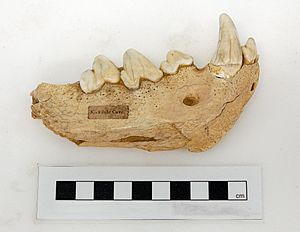Kirkdale Cave facts for kids
Quick facts for kids Kirkdale Cave |
|
|---|---|

Entrance to Kirkdale Cave
|
|
| Location | Vale of Pickering, North Yorkshire, England |
| OS grid | SE 6784 8560 |
| Length | 436 metres (1,430 ft) |
| Elevation | 58 metres (190 ft) |
| Discovery | 1821 |
| Geology | Jurassic Corallian Limestone |
| Entrances | 1 |
| Access | Entrance is in face of old quarry |
Kirkdale Cave is a famous cave and fossil site in Kirkdale, near Kirkbymoorside, in North Yorkshire, England. It's located in an area called the Vale of Pickering.
Workers discovered the cave in 1821. Inside, they found amazing fossilized bones of many different mammals. These animals don't live in Great Britain today. They included hippopotamuses (the most northern hippo remains ever found!), elephants, and lots of cave hyenas.
A scientist named William Buckland studied the cave in December 1821. He realized the bones were from animals brought into the cave by hyenas. The hyenas had been using the cave as their den. This was different from what some people thought, which was that the bones came from a big flood. Buckland's work was admired because he could figure out what an ancient ecosystem was like just by looking at fossils.
The cave was originally about 175 meters long. In 1995, the Scarborough Caving Club extended it to 436 meters.
Fossils Found in Kirkdale Cave
The fossil bones found in Kirkdale Cave were from many different animals. These included elephants, hippopotamuses, rhinoceroses, hyenas, bison, and giant deer. There were also bones from smaller mammals and birds.
One of the most exciting finds was the hippopotamus remains. Kirkdale Cave is the furthest north in the world where hippopotamus bones have ever been discovered! Scientists also found a lot of fossilized hyena droppings (poop). These fossil remains were found in a layer of silt. This silt layer was sandwiched between layers of stalagmite, which are rock formations that grow up from the cave floor.
Why Kirkdale Cave is Important

The fossils from Kirkdale Cave became an important part of the Yorkshire Museum's collection. The scientific excitement caused by these discoveries even led to the creation of the Yorkshire Philosophical Society.
Even though some people disagreed with his ideas, William Buckland's study of Kirkdale Cave was seen as a great example. It showed how careful analysis of fossils could help us understand Earth's past. In 1822, the Royal Society gave William Buckland the Copley Medal for his paper about Kirkdale.
The president of the society, Humphry Davy, praised Buckland's work. He said that these studies helped establish a clear time period in Earth's history. It was like finding a fixed point to explore the vastness of ages and trace the history of living things back to their creation.
The Kirkdale Area
Kirkdale Cave is a special place. It is recognized as a Site of Special Scientific Interest (SSSI). This means it's protected because of its important natural features. It's also a Geological Conservation Review site.
Close to the cave is the St Gregory's Minster. This church has Saxon features and a very unusual Kirkdale sundial.

